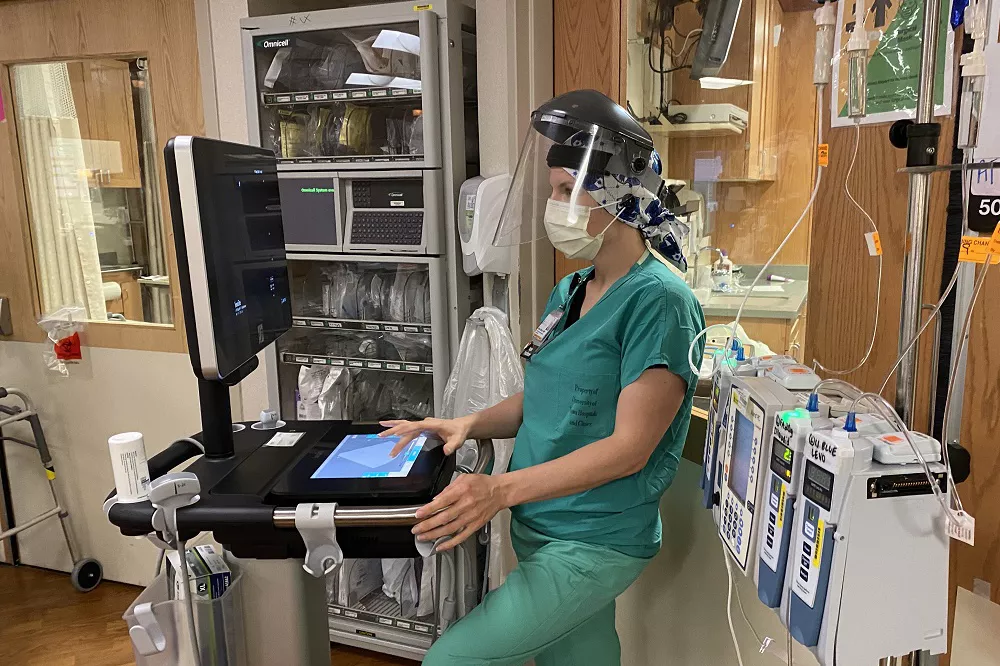Beating the odds: Behind the scenes in a COVID-19 unit

A closer look at the Medical Intensive Care Unit and why most days are full of optimism for faculty and staff.
When Allison Wynes, ARNP, calls the family members of COVID-19 patients in intensive care, the first messages are often difficult to share. So when her updates are good news, the conversations are especially memorable.
“You can hear the relief in their voice,” says Wynes, the lead advanced practice provider for the Medical Intensive Care Unit (MICU). “The gratefulness and the gratitude that they express is really rewarding.”
As one of UI Health Care’s units focused on COVID-19, the MICU is a challenging place, but most days are full of optimism and recovery.
“Our patients are doing really well—better than expected,” says Wynes. “Time will tell if that trend continues, but we’ve been doing these amazing things. Everyone is shining. We love our jobs, and we love being able to provide this level of care to our community.”
Committed to evidence-based medicine
Learning from peers in other states who saw early surges, the MICU team is a firm believer in evidence-based critical care for COVID-19 patients.
“While this disease clearly has some differences, the similarities just far outweigh the differences in what we’re used to treating,” says Kevin Doerschug, MD, MS, medical director of the MICU. “Our management is very close to what we’ve always done in our intensive care unit. We’re careful to look for potential differences, but not change without good clinical investigations.”
At a time when Twitter and other social media have been full of anecdotes on how to care for COVID-19 patients, it’s easy to see how emotion can influence recommendations for trial-and-error approaches. But when Doerschug sees this type of “expert” advice based on very limited experiences, it makes him cringe.
While the MICU is involved in institution-approved clinical trials for Remdesivir and convalescent plasma, along with a few other monitoring studies, their focus is on evidence-based medicine for respiratory failure and acute respiratory distress syndrome.
“We’re doing what we’ve always been doing, and we’re getting good outcomes,” says Doerschug. “We try to keep things simple and just do the simple things really, really well.”
New levels of collaboration
Like so many other teams within UI Health Care, the MICU embodies the “we stand together” spirit.
“Our interdisciplinary collaboration has always been good, but it’s been brought to a new level,” says Austin Kannegieter, BSN, RN, MBA, nurse manager in the MICU. “We really have done very well in caring for our patients. That’s been very encouraging, but we wouldn’t be able to do that without collaboration, communication, and streamlined practices.”
While many people with COVID-19 have mild or no symptoms, the disease can cause fluid buildup in the lungs and decreased oxygen flow into the bloodstream, causing people to become very sick.
In the MICU, advanced oxygen delivery devices are typically used first to try to prevent a patient from ending up on a ventilator. Really good supportive care—which often includes proning (flipping a patient on their belly to help with oxygenation), respiratory therapy, and physical therapy—also are important.
“It’s very hard for people to comprehend that sick people should be moving,” says Doerschug. “Perhaps one of the most important things is that patients need to be protected from being bed bound.”
If a ventilator is needed, the team recognizes the importance of good ventilator management to optimize settings for the patient and prevent further injury to the lungs.
ECMO, or Extracorporeal Membrane Oxygenation, may also be an option for some of the sickest patients who need to let their lungs rest and heal. UI Hospitals & Clinics has decades of experience in providing ECMO support for the management of life-threatening pulmonary failure, and is one of 31 ECMO Centers of Excellence in the world with gold-level standing.
“It’s not uncommon for us to have patients on a ventilator or ECMO support be able to walk down the hallway,” says Doerschug.
A safe place
As Wynes comes to work, she’s grateful for everyone who has stayed home because the number of COVID-19 patients in intensive care has been manageable so far.
“We’ve been able to provide patient care at the level that’s needed, with the consistency and frequency that’s needed,” she says. “Our biggest fear is having too many patients. The amount of specialized care that COVID-19 patients need is so great. It’s important to remember that this takes highly trained nurses and providers who are comfortable doing what they’re doing.”
According to Kannegieter, one of the first steps in preparing for COVID-19 patients was working with epidemiology to build confidence in donning and doffing practices related to personal protective equipment and make it part of the workflow.
“We’ve proven over the early course of things that this is a safe place,” says Kannegieter. “Despite having a very high number of COVID-19 patients, we’ve been able to maintain a zero incidents level with staff in the MICU.”
And while their work can still be emotional and scary at times, Kannegieter is proud of how the team has found ways to be vigilant and consistent.
“It’s been super encouraging to see good outcomes for our patients and proven safety for our staff,” he says. “It really validates all the steps that we’ve taken, and all the hard work that we’ve put in.”